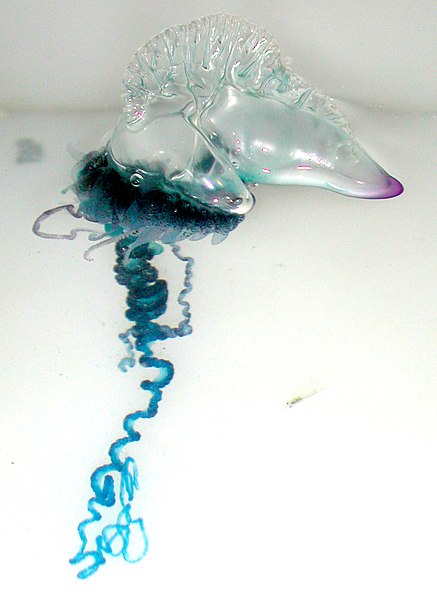 Growing up in the Midwest of the United States, and taking several trips over my lifetime to an Atlantic or Gulf of Mexico beach, I recall the vague consideration of the floating jellyfish. Maybe it's hard to see them, but they will hurt a lot of you touch one of their venomous cells. And, there were certainly few horror stories that need not be transcribed here. Watching the Pixar classic "Finding Nemo" provides a daunting realization--albeit digitally conceived--of the beauty and the devastation of the jellyfish bloom.
Growing up in the Midwest of the United States, and taking several trips over my lifetime to an Atlantic or Gulf of Mexico beach, I recall the vague consideration of the floating jellyfish. Maybe it's hard to see them, but they will hurt a lot of you touch one of their venomous cells. And, there were certainly few horror stories that need not be transcribed here. Watching the Pixar classic "Finding Nemo" provides a daunting realization--albeit digitally conceived--of the beauty and the devastation of the jellyfish bloom.Apparently, the jellyfish population in the Mediterranean Sea is of considerable concern to scientists, tourism officials, and beach combers alike. So much so, the Island of Malta has established a citizen science program to track the common and not-so-common jellyfish populations that surround their little paradise (visit). Lead by the University of Malta and the IOI-Kids of the International Ocean Institute, the "Spot the Jellyfish" program engages children, teachers, parents, and tourists to keep a keen eye out for the gelatinous monsters.
An incredible array of species have already been identified all around the islands, including the the surface-dwelling blue button (Porpita porpita), the cigar jellyfish (Olindias phosphorica), the comb jellies (ctenophores), the mauve stinger (Pelagia noctiluca), and the jelly-like invertebrate, the Portuguese_Man_o'_War.
 If you stare at images of these amazing creatures long enough, you might start considering that you live on another planet or are from a very different epoch of Earth's history. They are such interesting creatures, yet they don't seem to make much sense with their transparent, floating-with-the-current routine. Despite this thought, the species are numerous and they flourish in their blooming communities around the entire globe. So, somewhere along the time line, evolution found them to be stable, useful organisms.
If you stare at images of these amazing creatures long enough, you might start considering that you live on another planet or are from a very different epoch of Earth's history. They are such interesting creatures, yet they don't seem to make much sense with their transparent, floating-with-the-current routine. Despite this thought, the species are numerous and they flourish in their blooming communities around the entire globe. So, somewhere along the time line, evolution found them to be stable, useful organisms.An interactive map of the identified jellies around Malta--including those with and without stingers--is presented online (view) with reporting from within the previous twenty-four hours. Not only, then, can this be a vital research tool for better understanding the population dynamics of jellyfish species in the region, but it can also be used by tourists and locals wanting to take a break in the waves as to what sort of species have been recently observed.
In addition, the dynamic nature of the jellyfish blooms with respect to ocean climate, is not fully understood. Claudia E. Mills of the University of Washington has been studying these little buggers for over three decades, and is trying to determine what sort of impact regional ecological changes are having on species of jellies. With populations exploding in some areas and decreasing in others, a sort of species filtering might be underway. However, a better understanding of the connection between the local ecologies and the species must be developed first to predict the future of the jelly fish. Organized citizen science activities certainly can support this sort of research, and the Maltese program would provide a thorough template for a successful outreach to the public and their mass data collection efficiencies.
... ...
"Jellyfish campaign reports uncommon species" :: TimesOfMalta.com :: July 30, 2010 :: [ READ ]
Spot the Jellyfish - An IOI-Kids Initiative :: [ VISIT ]
"Jellyfish blooms: are populations increasing globally in response to changing ocean conditions?" Mills, C. E., Hydrobiologia 451: 55–68 (2001) [ DOWNLOAD and READ pdf ]
Map of Malta [ VIEW ]
Images:
(1) The upside-down jellyfish is an uncommon species recently found around the Maltese Islands; from Spot the Jelly Fish
(2) Portuguese Man-O-War (Physalia physalis); Courtesy Wikimedia Commons.





Comments